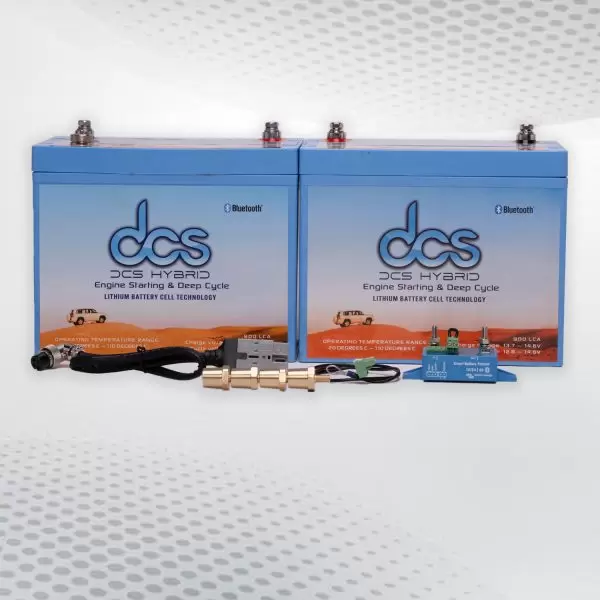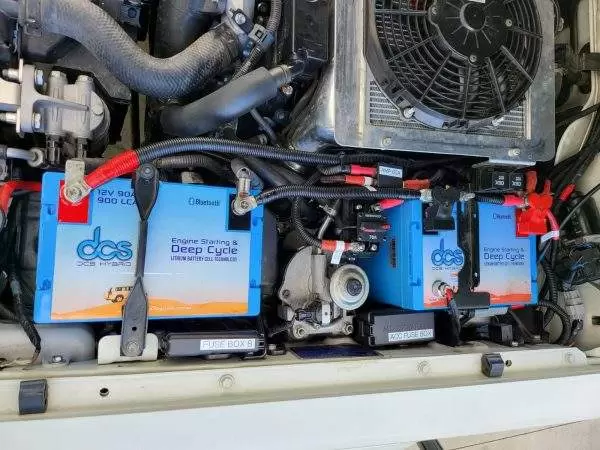Do you want to take your off-road adventures to the next level? Have you considered upgrading your vehicle with a lithium dual battery system? If so, then you’re in the right place! In this blog post, we’ll discuss the benefits and potential of the lithium dual-battery system and how you can get the most out of it for your on-the-go lifestyle. You’ll learn how this system can power your electronics, charge devices faster, and save you money in the long run.
What Is A Lithium Dual-Battery System?
A Lithium Dual-Battery System, also known as a dual-battery setup, is a power solution designed to provide extended periods of electricity supply to power appliances and devices during off-grid trips, camping, or other outdoor activities. It comprises two or more batteries connected in parallel to achieve maximum capacity and efficiency. Outdoor enthusiasts, boaters, and over landers commonly use this setup to power fridges, lighting systems, and other electronics.
Unlike traditional lead-acid batteries, lithium dual-battery setups are lighter, more compact, and have a longer lifespan. They also discharge slowly and can be charged faster, making them an excellent alternative for off-grid energy storage. Using a Lithium Dual-Battery System ensures an uninterrupted power supply, so you never have to worry about running out of battery.
Benefits of a Lithium Dual-Battery Setup
One of the primary benefits of a lithium dual-battery setup is increased power availability for off-grid activities, such as camping, boating, or off-roading. With a dual-battery system, you can have a dedicated starting battery for your engine and a separate deep-cycle battery for your appliances and accessories. Lithium batteries are more energy-dense and lightweight than traditional lead-acid batteries, providing a longer lifespan and faster charging times.
This means you can enjoy more power for longer periods without worrying about weight limitations or battery maintenance. Moreover, a lithium dual-battery system is an ideal solution for safety and reliability, providing a backup power source in case of emergency or unforeseen situations. By isolating the starting and auxiliary systems, you can avoid running down both batteries simultaneously, ensuring that you always have a working battery.
Components of a Lithium Dual-Battery System
A Lithium Dual-Battery System consists of several essential components that work together to provide a reliable power source for your vehicle. These components include:
- Primary Battery: Your vehicle’s primary battery is responsible for starting the engine.
- Secondary Battery: The secondary battery is an auxiliary power source that powers your vehicle’s accessories and electrical appliances.
- Battery Isolator: The isolator separates the two batteries, ensuring that the primary battery is not drained when using the secondary battery.
- DC-to-DC Charger: This device charges the secondary battery using power from the primary battery while the vehicle runs.
- Battery Monitor: A battery monitor displays the voltage, current, and state of charge of both batteries, providing critical information about the status of your system.
Combining these components, a Lithium Dual-Battery System ensures that you always have a reliable power source to power your vehicle’s electrical appliances and accessories.
How to Install Lithium Dual Battery Setup
Installing a Lithium Dual-Battery Setup requires careful planning and attention to detail. It’s important to have a solid understanding of the components and their respective functions before getting started. Here are the basic steps to follow when installing a lithium dual battery setup:
- Choose a suitable location for the batteries, keeping in mind the weight and size of the batteries and accessibility for maintenance.
- Install the battery isolator, which separates the two batteries and ensures that the primary battery is charged first before charging the secondary battery.
- Connect the battery monitor, which allows you to monitor the status of the batteries, such as the remaining charge, voltage, and temperature.
- Install the wiring for the charging system, ensuring that the wiring is correctly sized and rated for the load.
- Connect the battery terminals, following the manufacturer’s instructions and safety guidelines.
Once everything is connected, it’s important to test the system to ensure its functioning correctly before hitting the road. Proper installation of a Lithium Dual-Battery System is crucial for achieving the maximum benefits from your setup.
Maintaining and Troubleshooting a Lithium Dual-Battery System
While the Lithium Dual-Battery System is designed to be efficient and reliable, it’s important to maintain it regularly and troubleshoot any issues that may arise. Here are some tips to ensure the longevity and functionality of your Lithium Dual-Battery Setup:
- Regularly inspect and clean the battery terminals to prevent corrosion.
- Keep the battery charged and avoid over-discharging, as it can shorten lifespan.
- Use a smart battery charger to maintain optimal charge levels.
- Test the batteries periodically to ensure they are performing as expected.
- Replace any faulty or damaged components immediately.
- If you encounter any issues with your Lithium Dual-Battery System, refer to the manufacturer’s instructions or consult a professional to troubleshoot the problem.
By taking the time to maintain and troubleshoot your Lithium Dual-Battery Setup, you can ensure a reliable and efficient power source for all your on-the-go adventures.
Lithium Dual-Battery System For Over Landing And 4×4 Adventures
Having reliable power is essential when it comes to over landing and 4×4 adventures. The lithium dual-battery system provides a solution that can handle off-road travel demands, ensuring you never run out of power. This setup allows you to run your fridge, lights, and other devices longer, even when you’re not close to a power source.
The system is ideal for those who enjoy remote camping and exploring far-flung places. You don’t have to worry about the battery running low, even using a winch or powering high-drain equipment. You can charge one battery while the other is in use, so you always have power on the go.
For those planning extended trips, it’s advisable to have a backup plan. Consider carrying a solar panel or portable generator as a secondary power source. The dual-battery system can be expanded with additional batteries to extend the capacity further. This way, you can rest easy, knowing that you have the power to get you through your adventure.
Designing an Efficient Lithium Dual-Battery System
Designing an efficient Lithium Dual-Battery System requires understanding the specific power requirements of your vehicle or application. It’s important to consider factors such as the capacity and power of the batteries, the system’s size and weight, and the setup’s overall efficiency. One important consideration is the type of battery chemistry used in the system. Lithium-ion batteries are typically the most efficient option, but choosing a reputable brand is important to ensure reliability and safety.
When selecting components for the system, it’s important to ensure that they are compatible and optimized for efficiency. For example, selecting a high-efficiency alternator and solar charging system can maximize the charging speed of the batteries and reduce overall charging time. It’s also important to consider the physical layout of the system, such as the placement of the batteries and wiring, to ensure optimal efficiency and safety. Proper ventilation and cooling are crucial for preventing overheating and extending the lifespan of the batteries.
Future Trends and Advancements in Lithium Dual-Battery Systems
As lithium dual-battery systems continue to grow in popularity, we expect to see several advancements and improvements in technology. One such modification is using lithium-iron-phosphate (LiFePO4) batteries, which offer longer lifespans and better safety than traditional lithium-ion batteries. Another trend is integrating battery management systems (BMS) to monitor and optimize the performance of the dual-battery setup.
BMS technology can prevent overcharging and overheating, ensuring the longevity of the battery system. As renewable energy sources become more prevalent, we may also see more lithium dual-battery systems incorporating solar panels or wind turbines. This would enable over landers and off-grid adventurers to recharge their battery systems while on the go, reducing their reliance on fossil fuels.
Integrating Renewable Energy Sources
One of the most significant advantages of a lithium dual-battery system is that various renewable energy sources can charge it. This feature is highly desirable, especially for people who love the outdoors and want to live off the grid. With solar panels, wind turbines, and other alternative energy sources, you can ensure that your battery bank is always fully charged. The advantage of using renewable energy sources is that they are clean and reliable.
Moreover, using renewable energy means you will have to rely on something other than traditional electricity sources, which can be unreliable and polluting. When designing a lithium dual-battery system, it’s essential to consider the charging source. You need to choose the right type of battery that can handle the charging and discharging cycles efficiently.
Additionally, you’ll need to select a charge controller that can regulate the charge from the renewable energy source and prevent overcharging or undercharging. Proper planning and design allow you to have a reliable and sustainable power source for your adventures and everyday needs.
FAQ’s
What is the difference between a lithium dual-battery system and a single-battery setup?
A dual-battery system includes two lithium batteries that power a vehicle or equipment, while a single-battery setup only has one battery.
How long does a lithium dual battery system last?
The lifespan of a lithium dual battery system can vary depending on factors such as usage and maintenance. Generally, a well-maintained lithium battery can last between 5-7 years.
Can I install a lithium dual-battery system myself?
It is recommended to have a professional install a lithium dual-battery system to ensure proper installation and safety.
Can a lithium dual-battery system be used with solar panels?
Yes, a lithium dual-battery system can be used with solar panels to recharge the batteries with renewable energy sources.
What should I do if my lithium dual-battery system stops working?
It is important to troubleshoot the system and check for any issues, such as loose connections or battery failure. If necessary, consult with a professional for repairs or replacement.
Conclusion
The Lithium Dual-Battery System has emerged as a game-changer for individuals who love outdoor adventures, road trips, or camping in remote locations. Its ability to provide reliable power to multiple devices and appliances offers a sense of security and freedom to explore without worrying about power constraints.
Whether you are a novice or an experienced enthusiast, designing and installing a Lithium Dual-Battery Setup is a simple and effective solution to enhance your travel experience. By considering the benefits, components, installation process, and maintenance, you can optimize the efficiency and performance of your system.
As advancements in technology and renewable energy sources continue to evolve, the Lithium Dual-Battery System has the potential to become an integral part of our everyday lives, reducing our dependence on grid-based power sources and promoting sustainable living.



